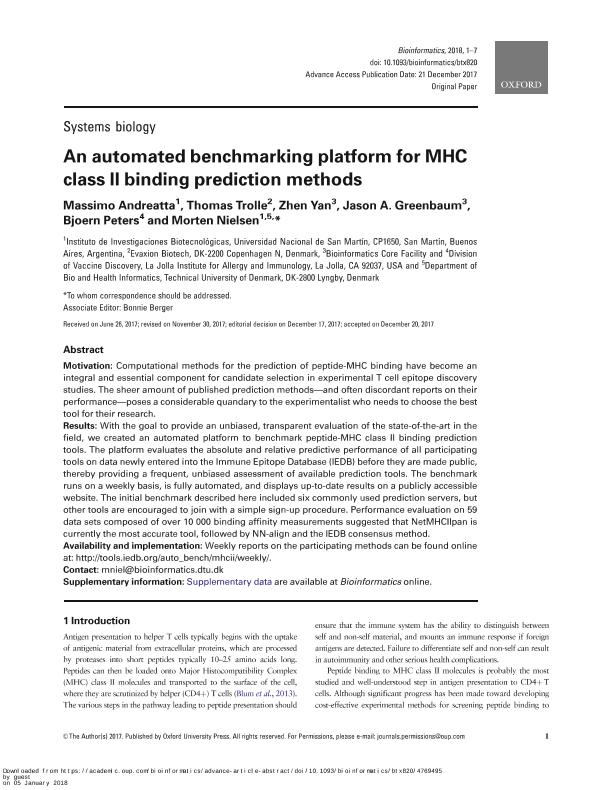Mostrar el registro sencillo del ítem
dc.contributor.author
Andreatta, Massimo

dc.contributor.author
Trolle, Thomas

dc.contributor.author
Yan, Zhen
dc.contributor.author
Greenbaum, Jason A
dc.contributor.author
Peters, Bjoern

dc.contributor.author
Nielsen, Morten

dc.date.available
2018-06-14T15:54:14Z
dc.date.issued
2018-05
dc.identifier.citation
Andreatta, Massimo; Trolle, Thomas; Yan, Zhen; Greenbaum, Jason A; Peters, Bjoern; et al.; An automated benchmarking platform for MHC class II binding prediction methods; Oxford University Press; Bioinformatics (Oxford, England); 34; 9; 5-2018; 1522-1528
dc.identifier.issn
1367-4803
dc.identifier.uri
http://hdl.handle.net/11336/48646
dc.description.abstract
Motivation: Computational methods for the prediction of peptide-MHC binding have become an integral and essential component for candidate selection in experimental T cell epitope discovery studies. The sheer amount of published prediction methods—and often discordant reports on their performance—poses a considerable quandary to the experimentalist who needs to choose the best tool for their research. Results: With the goal to provide an unbiased, transparent evaluation of the state-of-the-art in the field, we created an automated platform to benchmark peptide-MHC class II binding prediction tools. The platform evaluates the absolute and relative predictive performance of all participating tools on data newly entered into the Immune Epitope Database (IEDB) before they are made public, thereby providing a frequent, unbiased assessment of available prediction tools. The benchmark runs on a weekly basis, is fully automated, and displays up-to-date results on a publicly accessible website. The initial benchmark described here included six commonly used prediction servers, but other tools are encouraged to join with a simple sign-up procedure. Performance evaluation on 59 data sets composed of over 10 000 binding affinity measurements suggested that NetMHCIIpan is currently the most accurate tool, followed by NN-align and the IEDB consensus method.
dc.format
application/pdf
dc.language.iso
eng
dc.publisher
Oxford University Press

dc.rights
info:eu-repo/semantics/openAccess
dc.rights.uri
https://creativecommons.org/licenses/by-nc-sa/2.5/ar/
dc.subject
Mhc Class Ii
dc.subject
Prediction Methods
dc.subject
Iedb
dc.subject
Binding Affinity
dc.subject.classification
Ciencias de la Computación

dc.subject.classification
Ciencias de la Computación e Información

dc.subject.classification
CIENCIAS NATURALES Y EXACTAS

dc.title
An automated benchmarking platform for MHC class II binding prediction methods
dc.type
info:eu-repo/semantics/article
dc.type
info:ar-repo/semantics/artículo
dc.type
info:eu-repo/semantics/publishedVersion
dc.date.updated
2018-06-13T14:57:13Z
dc.journal.volume
34
dc.journal.number
9
dc.journal.pagination
1522-1528
dc.journal.pais
Reino Unido

dc.journal.ciudad
Oxford
dc.description.fil
Fil: Andreatta, Massimo. Consejo Nacional de Investigaciones Científicas y Técnicas. Centro Científico Tecnológico Conicet - La Plata. Instituto de Investigaciones Biotecnológicas. Universidad Nacional de San Martín. Instituto de Investigaciones Biotecnológicas; Argentina
dc.description.fil
Fil: Trolle, Thomas. Evaxion Biotech; Dinamarca
dc.description.fil
Fil: Yan, Zhen. La Jolla Institute for Allergy and Immunology; Estados Unidos
dc.description.fil
Fil: Greenbaum, Jason A. La Jolla Institute for Allergy and Immunology; Estados Unidos
dc.description.fil
Fil: Peters, Bjoern. La Jolla Institute for Allergy and Immunology; Estados Unidos
dc.description.fil
Fil: Nielsen, Morten. Consejo Nacional de Investigaciones Científicas y Técnicas. Centro Científico Tecnológico Conicet - La Plata. Instituto de Investigaciones Biotecnológicas. Universidad Nacional de San Martín. Instituto de Investigaciones Biotecnológicas; Argentina. Technical University of Denmark; Dinamarca
dc.journal.title
Bioinformatics (Oxford, England)

dc.relation.alternativeid
info:eu-repo/semantics/altIdentifier/doi/https://dx.doi.org/10.1093/bioinformatics/btx820
dc.relation.alternativeid
info:eu-repo/semantics/altIdentifier/url/https://academic.oup.com/bioinformatics/article-abstract/34/9/1522/4769495
Archivos asociados
